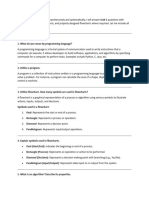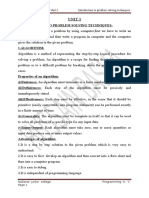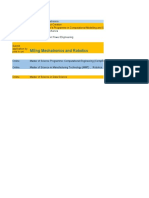ITC Lec06 Algorithms Flowcharts Pseudocode-I
Uploaded by
Anas AsifITC Lec06 Algorithms Flowcharts Pseudocode-I
Uploaded by
Anas AsifLecture 06: Algorithms Flowcharts Pseudocode
CS 101: Introduction to Computing
Algorithms Flowcharts Pseudocode
Saima Jabeen
Lec06: Algorithms Flowcharts Pseudocode
S 101: Introduction to Computing
Last time
Computer programming
Programming languages
Programming languages categorization
Algorithm
Today
Algorithms - Examples
Flowcharts
Expressing algorithms: Pseudocode
2
Lec06: Algorithms Flowcharts Pseudocode
S 101: Introduction to Computing
Calculate and print the average grade
of 3 tests for the entire class
Input
output
3 test scores for each student
Average of 3 tests for each student
Process
1.
2.
3.
4.
5.
6.
Get three scores
Add them together
Divide by three to get the average
Print the average
Repeat step 1 to 4 for next student
Stop if there are no more students
3
Lec06: Algorithms Flowcharts Pseudocode
S 101: Introduction to Computing
Flow Charts
A flowchart is a visual
representation of an algorithm.
The flowchart employs a series of blocks and
arrows, each of which represents a particular
operation or step in the algorithm.
The arrows represent the sequence in which the
operations are implemented.
or
graphical
Lec06: Algorithms Flowcharts Pseudocode
S 101: Introduction to Computing
Flowcharts Most Common Symbols
Function
Symbol Name
Terminal
Flow-line
Process
Represents the
of a program.
Represents the
flow of logic.
Represents calculations or data
manipulation.
Input/Output
Decision
beginning or end
Represents inputs or outputs
of data and information.
Represents a comparison,
question, or decision that
determines alternative paths to be
followed.
5
Lec06: Algorithms Flowcharts Pseudocode
S 101: Introduction to Computing
Flowcharts An Example
Find the solution of a quadratic equation
Ax2+Bx+C=0, given A, B and C.
START
INPUT
A, B, C
Calculate
R = SQRT(B2-4AC)
X1 = (-B+R)/(2A)
X2 = (-B-R)/(2A)
PRINT
A, B, C, X1, X2
END
Lec06: Algorithms Flowcharts Pseudocode
S 101: Introduction to Computing
Comparison of Algorithm representations in Natural language, flowchart and
Pseudo-code
START
Step 1: Begin the calculations
INPUT
A, B
Step 2: Input two values A and B
Step 3: Add the values
Add A to B
and store in C
Step 4: Display the result
Step 5: End the calculation
BEGIN Adder
Input A and B
C=A+B
PRINT C
END Adder
OUTPUT
C
END
Natural language
Flowchart
Pseudo-code
7
Lec06: Algorithms Flowcharts Pseudocode
S 101: Introduction to Computing
Algorithm Representation
(Natural Languages)
English or some other natural language.
Are not particularly good:
too verbose
Unstructured
too rich in interpretation (ambiguous)
imprecise
Lec06: Algorithms Flowcharts Pseudocode
S 101: Introduction to Computing
Algorithm Representation
(Using Programming Language)
{
int I, m, Carry;
int a[100], b[100], c[100];
cin >> m;
for ( int j = 0 ; k <= m-1 ; j++ ) {
cin >> a[j];
cin >> b[j];
}
Carry = 0;
i = 0;
while ( i < m ) {
Lec06: Algorithms Flowcharts Pseudocode
S 101: Introduction to Computing
Pseudo-code
Pseudo-code = English but looks like programming
Pseudocode is an artificial and informal language that helps
programmers develop algorithms.
Computer scientists use pseudo-code to express
algorithms:
English like constructs (or other natural language), but
modeled to look like statements in typical programming languages.
Good compromise
Simple, readable, no rules, don't worry about punctuation. Lets
you think at an abstract level about the problem.
Contains only instructions that have a well-defined structure and
resemble programming language
10
Lec06: Algorithms Flowcharts Pseudocode
S 101: Introduction to Computing
Pseudo-code Primitives
Three basic kind of operations:
Sequential
Computation ( Set )
Input/Output ( Get ... / Print ... )
Conditional
If Else
If
Iterative / looping
Repeat
While ...
11
You might also like
- CNC Milling Machine - FYP Final Report - V164% (11)CNC Milling Machine - FYP Final Report - V157 pages
- ITC Lect 06 (Algorithms Flowcharts Pseudocode-I)No ratings yetITC Lect 06 (Algorithms Flowcharts Pseudocode-I)10 pages
- Sessions 2-3 (Algorithms and Flowchart)No ratings yetSessions 2-3 (Algorithms and Flowchart)24 pages
- Algorithms and Flowcharts Are Two Different Ways of Presenting The ProcessNo ratings yetAlgorithms and Flowcharts Are Two Different Ways of Presenting The Process20 pages
- File 1697097709 GUSCSE202332294 Unit-IAlgorithmNo ratings yetFile 1697097709 GUSCSE202332294 Unit-IAlgorithm14 pages
- Introduction To: Algorithms & FlowchartsNo ratings yetIntroduction To: Algorithms & Flowcharts26 pages
- Introduction To Computing Technologies-ICTNo ratings yetIntroduction To Computing Technologies-ICT30 pages
- Christmas Term - JS 2 ICT - Week 6-7 - Computer Programming Language IINo ratings yetChristmas Term - JS 2 ICT - Week 6-7 - Computer Programming Language II25 pages
- Cs3271 - Programming in C Laboratory Manual 2021-2022No ratings yetCs3271 - Programming in C Laboratory Manual 2021-202250 pages
- Programming Lab 6: - Example First Mid-Term Exam QuestionsNo ratings yetProgramming Lab 6: - Example First Mid-Term Exam Questions2 pages
- Logical Flow of A Program: Algorithms, Flowcharts, PseudocodeNo ratings yetLogical Flow of A Program: Algorithms, Flowcharts, Pseudocode20 pages
- C++ Programming: From Problem Analysis To Program Design, Fifth EditionNo ratings yetC++ Programming: From Problem Analysis To Program Design, Fifth Edition48 pages
- Xi Cs Unit-2 Introduction to Problem SolvingNo ratings yetXi Cs Unit-2 Introduction to Problem Solving25 pages
- 23CSE101 IP QUESTUION BANK FOR ALL UNITS UpdatedNo ratings yet23CSE101 IP QUESTUION BANK FOR ALL UNITS Updated8 pages
- The Bcs Higher Education Qualifications BCS Level 4 Certificate in ITNo ratings yetThe Bcs Higher Education Qualifications BCS Level 4 Certificate in IT6 pages
- B.1 Types of Flowcharts: Saturday, 29 August 2020 1:13 PMNo ratings yetB.1 Types of Flowcharts: Saturday, 29 August 2020 1:13 PM14 pages
- Unit 1: JR CSE Unit-I Introduction To Problem Solving Techniques0% (1)Unit 1: JR CSE Unit-I Introduction To Problem Solving Techniques11 pages
- CSE101 - Lec 2 (Algorithm and Flowchart)No ratings yetCSE101 - Lec 2 (Algorithm and Flowchart)33 pages
- Chapter_1_Introduction to Algorithms and CNo ratings yetChapter_1_Introduction to Algorithms and C66 pages
- WochenstundenplΣne HCI WS20-21 Stand 27Okt20No ratings yetWochenstundenplΣne HCI WS20-21 Stand 27Okt201 page
- WochenstundenplΣne CS4DM WS20-21 Stand 27Okt20No ratings yetWochenstundenplΣne CS4DM WS20-21 Stand 27Okt201 page
- Rules and Guidelines - GSD Musabaka 2017No ratings yetRules and Guidelines - GSD Musabaka 20174 pages
- Importing A Catia File Into SolidWorks With AdobeNo ratings yetImporting A Catia File Into SolidWorks With Adobe2 pages
- Engineering Design Ch08 PG 1 of 2 SolmanNo ratings yetEngineering Design Ch08 PG 1 of 2 Solman90 pages
- Components of Computer and Data Representation: Saima JabeenNo ratings yetComponents of Computer and Data Representation: Saima Jabeen18 pages
- ITC Lec05 Computer Software and Programming100% (1)ITC Lec05 Computer Software and Programming11 pages
- MRSPTU PGDCA 1st Year Syllabus 2019 Batch Onwards On 25-07-2019100% (1)MRSPTU PGDCA 1st Year Syllabus 2019 Batch Onwards On 25-07-20199 pages
- System 1: Optimization and Diagnostics SoftwareNo ratings yetSystem 1: Optimization and Diagnostics Software14 pages
- DBMS BSC V Sem 31-Dec-2020 Unit-5 Complet Pages 178 N1No ratings yetDBMS BSC V Sem 31-Dec-2020 Unit-5 Complet Pages 178 N1178 pages
- Computer Fundamentals-1L1CS - LessonPlan2024No ratings yetComputer Fundamentals-1L1CS - LessonPlan20243 pages
- PM5560 PM5563 PublicFirmwareRevisionHistory v2.1.0 PDFNo ratings yetPM5560 PM5563 PublicFirmwareRevisionHistory v2.1.0 PDF3 pages
- Lab 04: Basics of Javascript: Sel-310 Web Engineering LabNo ratings yetLab 04: Basics of Javascript: Sel-310 Web Engineering Lab8 pages
- "LUCAS" For The Amiga 1000: A 68020168881 Platform BoardNo ratings yet"LUCAS" For The Amiga 1000: A 68020168881 Platform Board8 pages
- Pegasus3 R4 / R6 / R8 Compatibility List V1.4: Document HistoryNo ratings yetPegasus3 R4 / R6 / R8 Compatibility List V1.4: Document History4 pages
- BCIT MANUAL - STUDENT COPY-Bio-Medical-31-36No ratings yetBCIT MANUAL - STUDENT COPY-Bio-Medical-31-366 pages
- Chapter Three Number System and Data RepresentationNo ratings yetChapter Three Number System and Data Representation14 pages
- Ccome-C30: Carrier Board For Com-Express Type 6 Module On 3.5" Form FactorNo ratings yetCcome-C30: Carrier Board For Com-Express Type 6 Module On 3.5" Form Factor60 pages
- Algorithms and Flowcharts Are Two Different Ways of Presenting The ProcessAlgorithms and Flowcharts Are Two Different Ways of Presenting The Process
- Christmas Term - JS 2 ICT - Week 6-7 - Computer Programming Language IIChristmas Term - JS 2 ICT - Week 6-7 - Computer Programming Language II
- Cs3271 - Programming in C Laboratory Manual 2021-2022Cs3271 - Programming in C Laboratory Manual 2021-2022
- Programming Lab 6: - Example First Mid-Term Exam QuestionsProgramming Lab 6: - Example First Mid-Term Exam Questions
- Logical Flow of A Program: Algorithms, Flowcharts, PseudocodeLogical Flow of A Program: Algorithms, Flowcharts, Pseudocode
- C++ Programming: From Problem Analysis To Program Design, Fifth EditionC++ Programming: From Problem Analysis To Program Design, Fifth Edition
- The Bcs Higher Education Qualifications BCS Level 4 Certificate in ITThe Bcs Higher Education Qualifications BCS Level 4 Certificate in IT
- B.1 Types of Flowcharts: Saturday, 29 August 2020 1:13 PMB.1 Types of Flowcharts: Saturday, 29 August 2020 1:13 PM
- Unit 1: JR CSE Unit-I Introduction To Problem Solving TechniquesUnit 1: JR CSE Unit-I Introduction To Problem Solving Techniques
- Components of Computer and Data Representation: Saima JabeenComponents of Computer and Data Representation: Saima Jabeen
- MRSPTU PGDCA 1st Year Syllabus 2019 Batch Onwards On 25-07-2019MRSPTU PGDCA 1st Year Syllabus 2019 Batch Onwards On 25-07-2019
- DBMS BSC V Sem 31-Dec-2020 Unit-5 Complet Pages 178 N1DBMS BSC V Sem 31-Dec-2020 Unit-5 Complet Pages 178 N1
- PM5560 PM5563 PublicFirmwareRevisionHistory v2.1.0 PDFPM5560 PM5563 PublicFirmwareRevisionHistory v2.1.0 PDF
- Lab 04: Basics of Javascript: Sel-310 Web Engineering LabLab 04: Basics of Javascript: Sel-310 Web Engineering Lab
- "LUCAS" For The Amiga 1000: A 68020168881 Platform Board"LUCAS" For The Amiga 1000: A 68020168881 Platform Board
- Pegasus3 R4 / R6 / R8 Compatibility List V1.4: Document HistoryPegasus3 R4 / R6 / R8 Compatibility List V1.4: Document History
- Chapter Three Number System and Data RepresentationChapter Three Number System and Data Representation
- Ccome-C30: Carrier Board For Com-Express Type 6 Module On 3.5" Form FactorCcome-C30: Carrier Board For Com-Express Type 6 Module On 3.5" Form Factor











































































































